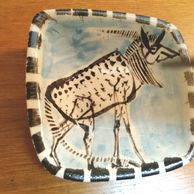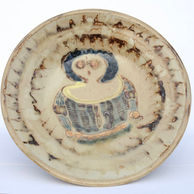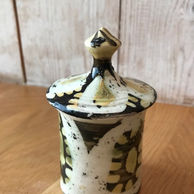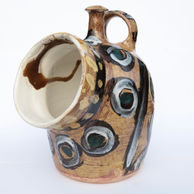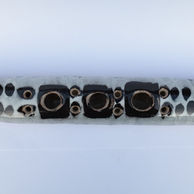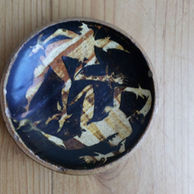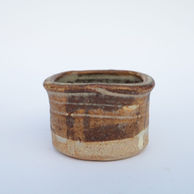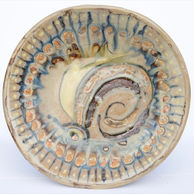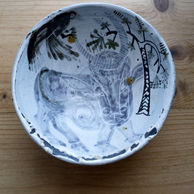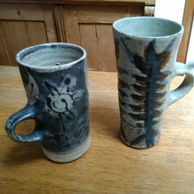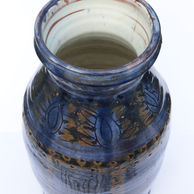
2. Heritage Museum / Taigh-Tasgaidh Dualchais Eilean Arainn
Listen to Gaelic translation
Located just North of Brodick, the Isle of Arran Heritage Museum is the perfect place to learn about the history and culture of the island.
Originally a small school, the museum gives visitors the chance to see a traditional farmhouse, smiddy and stables as well as many original and fascinating objects from the island's past.
With its emphasis on the lives of those who lived and worked on Arran, the museum is the ideal site for our place-maker celebrating the life of Hugh Purdie, a master potter. Hugh Purdie studied at the infamous Camberwell College of Arts and Craft Ceramics Department from 1946.
During this time strong connections existed between Bemard Leach and the Leach Pottery at St. Ives and Camberwell Ceramics Department and Hugh worked there during the holidays. In 1952 he exhibited his work alongside pottery giants such as Bernard Leach, Shoji Hamada, Michael Cardew, Lucy Rie and Hans Coper. In 1958 he returned to Arran and established Cladach Pottery.
Featured Artist
Purdie, Hugh
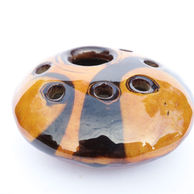
Hugh Purdie (or 'Jock' as he was known to his friends, students and colleagues during his Camberwell and London days) came to Arran in 1958 where, with Lady Jean Fforde and Tom Alexander as partners, he started a pottery at Cladach, known as Cladach Industries. He was then aged 51. He had discovered a talent for pottery rather late in life.
His early career, prior to the Second World War, had been spent working in Glasgow for the Caledonian Rail Company ('The Caley') in a clerical role and possibly as a draughtsman. The psychological and practical processes whereby he moved from this to being an original and inventive potter are not very clear. It is known that during the Second World War he was called up and had to take I.Q. tests and, in later life, described the high scores he achieved as a revelatory moment - one which gave him a motivating confidence in his own abilities.
It seems that he attended an evening course in painting at the Glasgow School of Art in the immediate aftermath of the war. A large painting by John Miller, later to be Head of Painting at the School of Art, of Hugh sitting on the rails of what appears to be Brodick Pier suggests that he was friendly with the painter and that, possibly, John Miller was his teacher.
The fact that the steamer is painted in grey camouflage colours suggests that the painting was done in the immediate post-war period. It is also known that by 1945/6 he had formed a very strong desire to go to Art College; not to do pottery but painting. This desire was so strong that when offered a place in 1946 at Camberwell College of Arts and Crafts he was prepared to leave his wife and young daughter and move to London.
The move to Camberwell, at the age of 40, plunged him into a radical and innovative atmosphere that was to have a profound effect on him. William Johnstone, a fellow Scot and an important painter in his own right, was principal of Camberwell from 1938 until 1947. Johnstone had definite ideas about how art and design should be taught. He believed that they were best taught through exposure to the influence of those who were themselves innovative practicioners, and after the war began a round of appointments which implemented this belief. Victor Pasmore, William Coldstream, Claude Rogers and Lawrence Gowing, influential members of the Euston Road group, would have all been at Camberwell during Hugh's period there, and he would have been exposed to their ideas and practices. At some stage, possibly in his second year, he decided to specialise in pottery.
This may have been partly due to Richard Kendall, who had worked with Bernard Leach, and who was appointed to Camberwell Ceramics Department in 1946. A strong connection existed throughout this period between Bernard Leach and the Leach Pottery at St. Ives and Camberwell Ceramics Department and Hugh worked there and at Ramsbury during his vacations. By all accounts Richard Kendall was an enthusiastic, humorous and skilful teacher. Also working in the department at this time was Norah Bradon, a well-known and innovative potter, who had worked with Bernard Leach in the 1920s and then with Katherine Pleydell-Bouverie at the Coleshill Pottery. Both of these teachers, and the time spent in St. Ives and Ramsbury, must have had a considerable influence on the development of Hugh's pottery. He was awarded an N.D.D. in 1950 with a higher merit in terracotta work. The terracotta tile he submitted for his final examination was so large that it provoked the examiners to specify a maximum size for future examinations.
It also demonstrated what were to become the main characteristics of many of his pots - their boldness of scale, their formal vigour, their uninhibited decoration and their stylised, sometimes heraldic, representation of plants and animals. His sketchbooks from this time reveal an interest in pottery ranging across many cultures and historical periods, including fifth century B.C. Greek pottery, twelfth century Persian, fifteenth century Spanish and seventeenth century Japanese, amongst many others. All of these would have been available for him to study through the V & A Museum and clearly influenced both shape and decorative motifs.
Between 1950 and 1958 he lived and worked in London. The precise details of his life during this period are hard to pin down. It seems that he turned down an offer to teach pottery full-time at Camberwell, choosing instead to teach adult classes on four evenings a week and Saturdays, and to run the L.C.C. Schools' Pottery Firing Centre at Stockwell. Both of these positions provided him with time and facilities to make and fire his own pots and sell them privately. In the former position he made his presence felt in two ways.
Firstly his pottery and teaching had considerable influence on the next generation of Camberwell ceramics students. Bryan Newman, himself a well-known potter, attended Hugh's evening and Saturday morning classes and remembers them with great pleasure, saying how much Hugh had contributed to his development as a potter. He goes on to say 'It is hard to describe his (Hugh's) pottery because it was uniquely his own style, but it was very strong and vigorous'. He also comments on Hugh's experimental attitude, whereby he created new bodies and glazes and new ways of decorating. Secondly he made his presence felt through the force of his personality.
The uninhibited and uncompromising character of his pottery was an expression of the man himself. Past students refer to him as 'taciturn tall and bearded' (Lewis-Evans in Hassall), and as 'having a famously explosive temper’ (Kerr in Hassall). Hassall describes him as having 'terrified sedate ladies in his evening classes with a kindly meant curse, which always sounded far worse in his broad Glaswegian accent'. He also comments on ‘Jock's’ distinctive appearance: 'He cut an impressive figure, tall, bearded, wearing a rather loud check jacket, flannel trousers and, irrespective of the climate, sandals and no socks'.
In 1952 an International Conference of Craftsmen in Pottery and Textiles took place at Dartington Hall. An exhibition Pottery and Textiles 1930-52 was held in conjunction with the conference; its purpose to bring 'together a selection of the best works done in hand-made pottery and textiles in the country since 1920'. This exhibition then toured the country showing at Edinburgh, London and Birmingham.
Among the twenty to thirty exhibitors were Bernard Leach, David Leach, Michael Leach, Shoji Hamada, Michael Cardew, Lucy Rie, Katherine Pleydell-Bouverie, William Staite-Murray, Marianne de Trey, Hans Coper and Hugh Purdie. The fact that Hugh is included shows how highly regarded his work was at this time. The catalogue describes his exhibit thus: '168 Porcelain Pot with lid'. The following brief biographical note is included:
'Hugh Purdie c/o Camberwell School of Art, Peckham Road, London, S.E. 5. Born October 13th 1907. Studied pottery and terracotta at Camberwell School of Arts and Crafts 1946-50. Worked during vacation at St. Ives and Ramsbury. Now works in earthenware, stoneware, porcelain and terracotta at Camberwell School of Arts and Crafts.'
In 1958 he returned to Scotland, rejoined his wife Dora and daughter Thea, and set up Cladach Industries(Arran) Ltd with Lady Jean Fforde and Tom Alexander as co-directors. The pottery was sited at what is now Allan Mackenzie's Leather workshop and the family lived in the two upper floors of the house at Cladach. Shards of broken pots can still be found at the rear of the pottery. Initially pots were sold through a shop at what is now Crofters, and also at Alexander's. It seems that as the time neared to open this shop, Hugh had not produced enough pots to prevent the shelves appearing sparsely stocked. Fortunately some friends and colleagues from Camberwell had rented 'Carlo' and were on hand to boost production. Joe Dixson (a painter and later to be vice-principal of Camberwell), Bryan Newman and Ken Butler (potters) all put their shoulders (perhaps one should say 'feet') to the wheel, and helped out.
Later the shop moved to a wooden prefabricated building in what is now the car park in front of Arran Active. The range of products sold expanded to include weaving, knitwear and jewellery. Later this shop was moved up to the garden at Barnhill and the pottery workshop was moved from Cladach to two outhouses there. Deeply affected by the long illness and death of his wife Dora he eventually stopped making pots in late 1970.
From the start of his move to Arran Hugh’s pots impressed with their bold designs, strong colour and vigorous forms and demand was high. A kiln-load of pots would sell out very quickly. To be sure of buying the pots they wanted customers needed to know when the next kiln-load was due in the shop. There was always a problem in matching supply to demand; not that Hugh saw this as a problem. His overriding motivation was to produce pots that satisfied his conception of what a good pot should be like, and he was reluctant to allow pots for sale that fell below this standard, despite the fact that they would have sold. This motivation could lead him into a deep anger and dissatisfaction with himself and his work. In such moods he would smash pots that many would have loved to possess and his eyes would blaze at what he considered to be facile judgments made by visitors to the pottery about the 'beauty' of his pots, and he would find it difficult to be civil. He hated the thought that he might churn out pots on demand. For Hugh creating good pots required thought, effort and the right kind of inner state. In more relaxed moods he was welcoming, good- humoured and generous of his time, and would be happy to engage in discussions ranging from art to football, and offer visitors the chance to 'throw' a pot.
He very rarely accepted commissions; if he did it was under the condition that the commissioner had to accept what he produced.
He had strongly-held views on the nature of art and creative activity. He hated the 'art'/'craft' distinction, whereby pottery was devalued as a non-creative and merely technical activity. His view was that human creativity could manifest itself in all aspects of life, from plumbing and personal relationships through to the 'high arts' of painting and sculpture. One of his favourite 'mantras' was, 'Everyone is an artist.' Another was, 'One of the most difficult things in life is to allow another person to be themselves'. These two mantras taken together, implying his belief that the complex web of social and personal relationships in which humans are necessarily embedded can restrict creativity.
He believed that a special atmosphere that is tolerant of freedom of expression, and that allows others to develop a strong sense of their own identity, is necessary to the development of creativity. He tried to live by this belief in his own personal relationships. He encouraged others to talk about, and pursue, the goals that were important to them - to develop their own identity and to challenge conventional social expectations that prevented this. His philosophy of art echoed that expressed by D. H. Lawrence in his ‘Fantasia of the Unconscious’, of which Hugh had a copy. Lawrence in his tum had been influenced by Nietzsche's concept of Dionysian art. Briefly this view was that the source of the creative impulse did not lie in the rational intellect, but in primal impulses situated deep in the psyche. These primal impulses were similar to energies and forces at work in nature. For Lawrence reason was often an enemy of creativity. Ideas, he said, were the most dangerous 'germs' mankind had been 'infected' with. We must learn to live from the 'solar plexus' or the unconscious. Hugh, it seems to me, subscribed to these kinds of ideas. He had many of the characteristics of the Lawrentian/Nietzschean artist – deeply felt emotions, passionate convictions, and a belief that art proper stemmed from deep instinctual forces.
John Andrews
References:
Hassall, Geoff. Camberwell School of Arts and Crafts: Its Students and Teachers 1943- 1960 (1995 Antique Collectors' Club)
Hall, Douglas. William Johnstone (1930 Edinburgh University Press)
Note
This paper is a revised version of one written for a major retrospective of Hugh Purdie’s pottery held at the Burnside Gallery in November 2003, ably curated by Mhairi Smeir.








